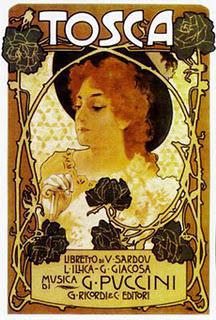Dicapo Opera celebrates 30 years with Tosca.

Libretto cover for Tosca published by Ricordi.
There is a moment in Act I of Tosca that I've never seen, until last night. It came when the title character (played by Kristin Sampson) nagged her lover Mario Cavaradossi to paint the eyes of the Virgin Mary black, (like hers) instead of blue.
In this new production by Dicapo general director Michael Capasso, (staged in celebration of the Upper East Side company's 30th year) Cavaradossi (played by tenor Peter Gage Furlong) actually mixed paint and blackened the eyes of the Virgin Mary, succumbing to Tosca's demands. It was just one of many small details that made this modest version of Puccini's opera a success.
If you're not familiar with Dicapo, this company puts on operas in a small "jewel box" theater on W. 76th St. in the basement of St. Jean Baptiste Church. Founded in 1981, it has proved a valuable resource for lovers of chamber operas, modern works of modest size, and repertory favorites staged with an intimacy unavailable at the 4,000-seat Met.
Kristin Sampson is an experienced singer in this house. She struck the right balance between fiery passion and loopy rage as Floria Tosca. She was tender in the first act, growling and determined in the second (with a pause for a lyric "Vissi d'arte") and positively loopy in the third. In her scene with Cavaradossi on the battlements, she seemed unusually collected as she explained the "staged" execution that was to come. But you could see the doubt in Mr. Furlong's eyes.
Mr. Furlong started with a lovely "Recondita armonia," keeping his lyric tenor voice right in the passagio. He had one shrill moment in the Act I duet with Tosca, when he lifted his voice up to its full height and found that its top was lacking in bloom. Like may tenors before him, he was defeated by "Vittoria!" the stentorian mini-aria that Puccini, (Scarpia-like) may have added just to torment his singers. But "E lucevan le stelle" shone forth in all its glory, with real emotion in the cavalier's farewell to life.
Guido LeBrón's Scarpia was not particularly suave, or seductive. He might have been more at home in Roberti's torture chamber, tightening the spikes himself during the interrogation scene. But he struck an imposing figure in his Act I entrance, thundering out his lust for Tosca in the middle of the Te deum. The second act revealed the police chief as a drooling psychopath, nearly raping Tosca as the room (a turntable set) literally spun around them. His death was staged in the same whirling, distracting manner.
Although the sound of Puccini-sized voices in a small theater can result in balance problems, this Tosca was blessed with a good supporting cast This extended to the smallest roles, with a good performance from character tenor George Kaserjian (a Mime-like Spoleta) and up-and-coming bass Brandon Coleman in the brief, ill-fated role of Angelotti. The choral work was solid.
It worked well for the Te deum, but the noisy turntable set proved distracting in the later acts, offering different views of the action but putting obstructing scenery in the way of the audience's line of site. In the second and third acts, Puccini's complex orchestrations were forced to battle with mechanical noise. In a small opera house like this one, less is sometimes more.



COMMENTS ( 1 )
posted on 16 October at 05:25
It's rather incredible that someone so ignorant of the libretto of TOSCA feels qualified to write a review of a performance of this most standard of works. As anyone well-acquainted with this score knows, Cavaradossi is not painting a portrait of the Madonna. Rather (as is stated over and over again in the text of Act I) he is painting La Maddalena (Mary Magdalene).